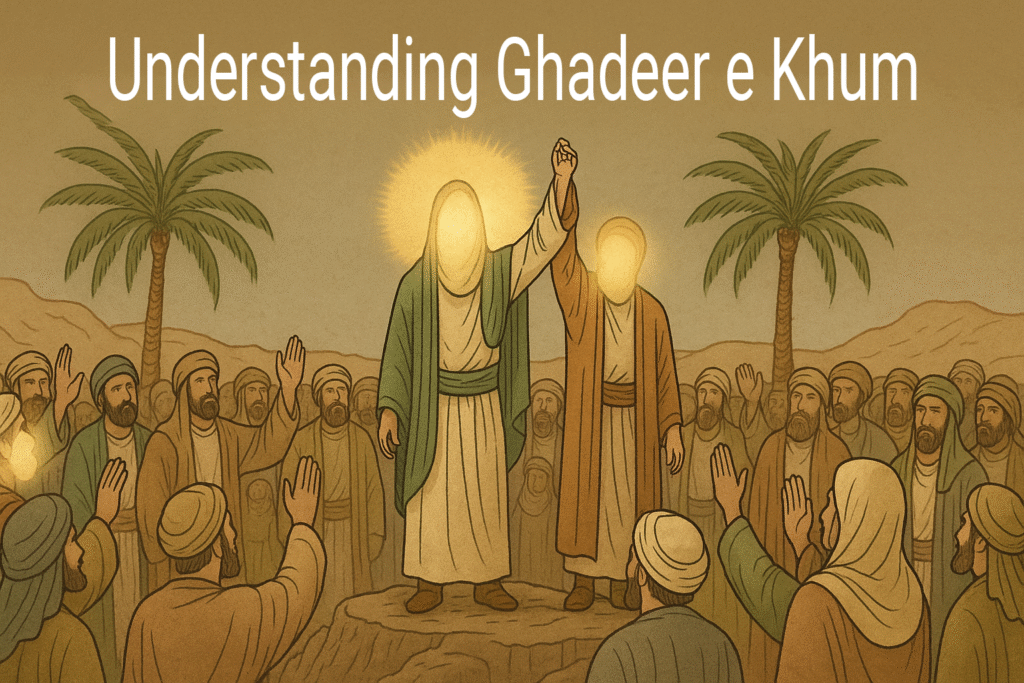Introduction
Ghadeer e Khum is one of the most important and defining events in the history of Shia Islam. It marks a moment of profound theological and spiritual significance that shapes the understanding of Islamic leadership and the role of the Ahl al-Bayt. This event took place shortly after the Prophet Muhammad’s (PBUH) final pilgrimage and is remembered as the occasion where the Prophet appointed Imam Ali as his successor, emphasizing the divine guidance of leadership in Islam.
For millions of Shia Muslims around the world, Ghadeer e Khum represents more than just a historical incident—it embodies the continuity of divine wisdom and leadership through Imam Ali and his descendants. In this article, we will explore the historical background, religious significance, and ongoing impact of Ghadeer e Khum on Shia beliefs and traditions. We will also discuss how this event connects deeply with the teachings of Prophet Muhammad (PBUH) and the role of Imam Ali in guiding the Muslim community.
What Happened at Ghadeer e Khum?
The event of Ghadeer e Khum occurred in 10 AH (632 CE), during the return journey from the Prophet’s last pilgrimage (Hajj). The location was a place known as Ghadeer, an oasis situated between Mecca and Medina. As the Prophet Muhammad (PBUH) and his companions traveled back, he stopped the caravan to address the gathered crowd.
Standing on an elevated platform, the Prophet delivered a significant sermon. The culmination of his address was a declaration that would forever alter Islamic history:
“Man kuntu maulahu fa hādhā ʿAlīyyun maulahu.”
“For whomever I am his maula (leader/guardian), Ali is also his maula.”
This proclamation was clear and unequivocal. It indicated that the authority and leadership entrusted to the Prophet by God were now being transferred to Imam Ali. Many companions immediately recognized the weight of this statement. Some, like Umar ibn al-Khattab, publicly congratulated Imam Ali on this divine appointment.
This moment, as recorded by numerous early Islamic historians and narrators, is seen as the Prophet’s explicit endorsement of Imam Ali’s leadership over the Muslim community.
Religious Significance in Shia Islam
In Shia Muslim traditions, Ghadeer e Khum holds a central place. Shia scholars affirm that this event was a divine mandate appointing Imam Ali as the rightful successor to Prophet Muhammad (PBUH). Unlike political leadership chosen by consensus, this appointment reflects God’s will, conveyed through the Prophet’s public pronouncement.
The doctrine of Imamate in Shia Islam is deeply tied to this event. It teaches that Imams are divinely chosen guides, endowed with special knowledge and authority to lead the Ummah in spiritual and worldly matters. Ghadeer e Khum is therefore viewed as the moment when this divine guidance was formalized.
Sunni interpretations, while respecting the event’s significance, tend to understand the term “Maula” more as “friend” or “ally,” without the implication of political succession. This respectful difference underscores the theological divergence but also reflects the shared reverence for both Prophet Muhammad (PBUH) and Imam Ali.
This event solidifies the foundation of Shia beliefs about leadership, justice, and spiritual authority, which continue to influence Shia Muslim traditions worldwide.
The Role of Imam Ali in the Event
Imam Ali holds a unique and revered position in Islamic history and especially within Shia Islam. Known for his wisdom, courage, and piety, he was the Prophet’s cousin, son-in-law, and one of the earliest and most devoted followers.
At Ghadeer e Khum, Imam Ali’s leadership qualities were recognized not just by the Prophet’s words but also through his exemplary character. The Prophet Muhammad (PBUH) repeatedly praised Imam Ali, referring to him as “the gateway to knowledge” and “the bearer of wisdom.”
Many other sayings attributed to the Prophet emphasize Imam Ali’s special status, such as:
“I am the city of knowledge, and Ali is its gate.”
This highlights Imam Ali’s role not only as a political leader but as the spiritual and intellectual guide appointed by the Prophet himself. For readers interested in a deeper understanding, explore our article on The Role of Imam Ali in Shia Islam.
Celebrating Ghadeer in Shia Muslim Traditions
Every year, Shia Muslims commemorate Eid al-Ghadeer, a joyous occasion that celebrates the declaration made at Ghadeer e Khum. This festival involves various rituals, including special prayers, sermons, and gatherings that recount the historical event and its significance.
One of the key practices during Eid al-Ghadeer is the pledge of allegiance (Bay’ah) to Imam Ali, reaffirming the community’s loyalty to the divine leadership established by the Prophet. In mosques and community centers worldwide, believers listen to sermons emphasizing the lessons of justice, loyalty, and devotion embodied by Imam Ali.
This celebration reinforces unity and reminds the faithful of the spiritual legacy of Ahl al-Bayt—the family of the Prophet Muhammad (PBUH)—and their ongoing role in guiding the Muslim Ummah.
Lessons and Ethical Teachings from Ghadeer
Ghadeer e Khum offers timeless lessons that resonate beyond historical context. At its core, the event highlights values such as justice, loyalty, and divine guardianship (Wilayah). These principles remain relevant for Muslims today as they navigate challenges in leadership, ethics, and community cohesion.
Justice, as exemplified by Imam Ali’s leadership, calls believers to uphold fairness and defend the oppressed. Loyalty, as emphasized in the pledge at Ghadeer, encourages steadfastness to faith and spiritual guidance. The concept of Wilayah affirms the belief in divinely appointed leadership that nurtures both faith and moral responsibility.
These teachings inspire Muslims to reflect on their own roles in promoting justice and unity within their communities.


